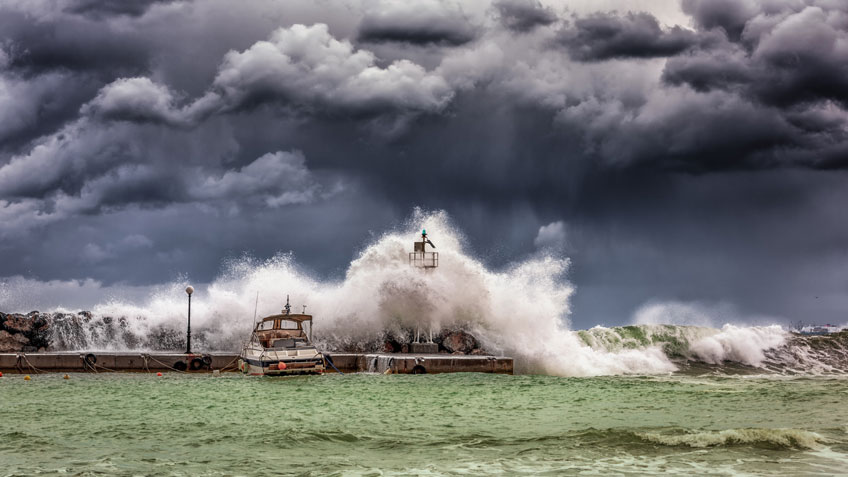Swimming With the SHARKS: NREL Makes a Splash at 2020 ARPA-E Funding Round

Hydrokinetic energy contained in tides, rivers, and ocean currents is renewable, reliable, abundant, and forecastable. Yet despite the long list of pros, a major strike against this promising, sustainable energy source is cost, stemming from both the challenging operating environment as well as the technical challenges of device deployment.
The U.S. Department of Energy's ARPA-E (Advanced Research Projects Agency—Energy) Submarine Hydrokinetic And Riverine Kilo-megawatt Systems (SHARKS) program is hoping to banish those barriers to future marine energy development.
With an expected $35 million in funding to dole out to high-risk, high-reward technologies over the next 3 years, the SHARKS program is sparking rapid innovation to scale the technical and environmental barriers to cost-competitive marine energy.
A National Renewable Energy Laboratory (NREL) project, along with three other NREL-supported projects, won this prestigious funding award in 2020.
The high cost of marine energy can be largely attributed to the unique challenges of installation, operation, and maintenance of these systems in the harsh tidal and riverine environments. And unlike the wind industry, the hydrokinetic turbine (HKT) industry has not yet been able to adopt innovations such as variable-speed and variable-pitch rotors to effectively contend with these conditions.
Typically, the HKT design process is sequential, meaning that control systems and components are designed independently of each other. That siloed approach can have significant negative implications for the levelized cost of energy (LCOE) of the resulting system.
A lack of tools to allow for the development and modeling of such HKT concepts is part of the problem. Currently, there are no fully coupled control co-design tools available for the design and optimization of HKT systems; however, the NREL team hopes to change this.
Receiving $1.2 million in support from the SHARKS program, NREL's "A Computer Tool To Control Co-Design Hydrokinetic Energy Systems" project will bring control co-design capabilities to tidal and riverine hydrokinetic turbines by leveraging the Wind Energy with Integrated Servo-control (WEIS) toolbox and OpenFAST codes that were originally developed for floating offshore wind. The NREL research team brings to the table a wealth of knowledge gained through prior wind energy research, as well as work carried out under previous ARPA-E ATLANTIS and U.S. Department of Energy Wind Energy Technologies Office funding.
The new modeling and co-design capability will address current gaps in HKT modeling by developing full-system modeling and control co-design capabilities for tidal, riverine, and ocean current energy systems. All codes will be made publicly available as they are developed and validated, providing immediate benefit to HKT developers and, potentially, even other SHARKS awardees.
It is the researchers' hopes that armed with these tools, developers and engineers can reap the efficiency gains of co-design, ultimately resulting in a more cost-effective marine energy system.
Playing a Supporting Role
In addition to the project NREL is leading, NREL researchers are supporting three other SHARKS program grantees through device modeling, component performance validation, and economic analysis:
- Tidal Power Tug, Aquantis Inc.
- Confinement-Exploiting Cross-Flow Turbine Arrays, University of Washington
- Control Co-design and Co-optimization of a Transformational Cost-Efficient Hydrokinetic Energy Turbine System, Littoral Power Systems Inc.
The Tidal Power Tug project led by Aquantis Inc. is a tidal HKT designed for power delivery to remote and local grids. The concept employs control co-design techniques to achieve stable operations in all sea conditions, as well as cost performance gains. The device will operate autonomously, and the control system can prioritize objectives, such as maintaining the lowest cost of energy, increasing component lifespans, and maximizing available energy.
The University of Washington's Confinement-Exploiting Cross-Flow Turbine Arrays project aims to capture the benefits of array power output and overall efficiency increases via cross-flow current turbines. The team proposes a control co-design process, combining advances in turbine control strategies, hydrodynamic configurations, and array geometry optimization to maximize power production under complex, unsteady flow conditions.
Littoral Power Systems Inc. hopes to substantially reduce the LCOE of marine energy through the design, fabrication, and testing of a novel in-current hydrokinetic energy turbine system. The Control Co-design and Co-optimization of a Transformational Cost-Efficient Hydrokinetic Energy Turbine System project team will employ a control co-design engineering framework to optimize their hydrokinetic energy turbine system for a reduction in LCOE.
From Toolbox to Tidal System
The development of such innovative tools and technologies could offer substantial quality of life improvements for remote communities with significant tidal and riverine resources, such as those found in Alaska.
Energy generation in many remote Alaskan communities entails shipping diesel over long distances and in harsh climates, relying upon expensive, environmentally unfriendly generators. Tidal energy could offer these communities a sustainable, cost-effective, and easily maintained power solution.
However, before such technologies can be adopted, they must be proven.
Follow the NREL team as they fine-tune their modeling tool and support partner innovations to enable the development of tomorrow's marine energy technologies.
Learn more about ARPA-E SHARKS and NREL's marine energy research.
Last Updated May 28, 2025
